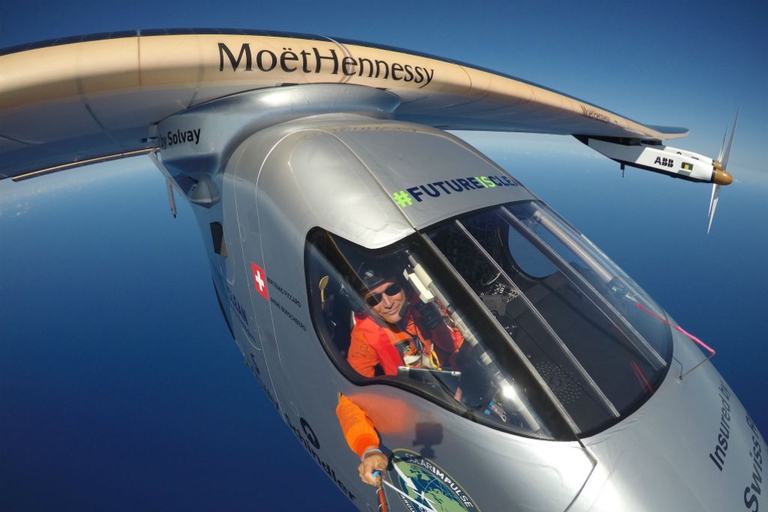
Milan has announced one of Europe’s most ambitious mobility schemes, known as Strade Aperte (open roads). Its goal is to reduce cars in phase 2 of the lockdown by increasing bike lanes and pedestrian areas.
L’aereo solare ha attraversato il Pacifico ed ora è tornato in volo verso Phoenix. Online la diretta del volo si Solar Impulse 2.
The solar-powered plane Solar Impulse 2 carried out the tenth flight of its around-the-world tour with no fuel. Despite it having stopped for a few months after its batteries were damaged, it arrived in the United States and started its journey across the country. It took off from San Francisco on the 2nd of March, piloted by André Borschberg, and landed in Phoenix. The flight lasted 15 hours and 52 minutes and covered 1,113 kilometres.
The previous flight had been across the Pacific Ocean and, as far as solar-powered planes are concerned, it broke several records, including distance, speed, duration and altitude. Thanks to pilot André Borschberg, Solar Impulse 2 set a world record, conducting a flight of 5 days and 5 nights.
“Solar Impulse showcases that today exploration is no longer about conquering new territories, because even the moon has already been conquered, but about exploring new ways to have a better quality of life on earth,” said Piccard, Initiator and Chairman of the project. “It is more than an airplane: it is a concentration of clean technologies, a genuine flying laboratory, and illustrates that solutions exist today to meet the major challenges facing our society.” This is a message of hope and pragmatism, which was also reported in occasion of the Paris Agreement signing ceremony on 22 April in New York City.
While electric vehicles are on the rise thanks to car manufacturers’ new offers, Piccard and Borschberg demonstrate that zero emissions, electric mobility is real and functioning, so much so that they travelled around the world.
“Solar Impulse is a demonstration of energy efficiency and smart energy management, similar to a flying grid. Just imagine your energy reserves increasing during flight and available day after day,” added André Borschberg, CEO and co-founder. “This is what we may be doing in our communities, our cities and our countries. To have a decentralized renewable energy production, using solar, thermal, wind”.
Siamo anche su WhatsApp. Segui il canale ufficiale LifeGate per restare aggiornata, aggiornato sulle ultime notizie e sulle nostre attività.
![]()
Quest'opera è distribuita con Licenza Creative Commons Attribuzione - Non commerciale - Non opere derivate 4.0 Internazionale.
Milan has announced one of Europe’s most ambitious mobility schemes, known as Strade Aperte (open roads). Its goal is to reduce cars in phase 2 of the lockdown by increasing bike lanes and pedestrian areas.
Formula 1, the world’s most important auto racing championship, has decided to turn the page and aim for carbon neutrality with the support of its teams, drivers and the whole racing circus.
Toyota and LifeGate began telling the story of hybrid mobility back in 2006, now, on the road to the Tokyo 2020 Olympics, they’re still treading the path of sustainable mobility. Here are the main steps of the journey.
Germany’s first solar bicycle lane could be the prototype for the roads of the future. The photovoltaic tiles melt snow and ice, and are capable of absorbing noise.
The Vespa is back in an electric version. Production has just started and the first models can be reserved online starting from October.
The city of Utrecht, in the Netherlands, is home to a bridge for cycling and walking that stretches over roof garden of a Montessori school. This project enhances practicality and will allow families to bring children to school by bike, passing through green areas. Despite their functionality, bridges are often seen as an infrastructure that is
The Lego hair bike helmet is the latest Internet craze. For now it’s just a prototype but production on a large scale will probably start soon.
Just as fires often give way to new growth, after the Dieselgate scandal, which saw Volkswagen cheating on US emission rules, the German car manufacturer radically changed course, beginning to focus on sustainable mobility. The German car company aims to propose thirty zero-emission models and produce at least one million battery electric vehicles by 2025. An ambitious mission
Sustainable, two-wheel mobility is triumphing in Copenhagen. After years of investments, policies, and infrastructural changes, bikes now outnumber cars in the city centre. The website Copenhagenize has released data linked to the number of vehicles entering the city centre, which are monitored by the city’s administration on a daily basis. Last year, 265,700 bikes have entered








